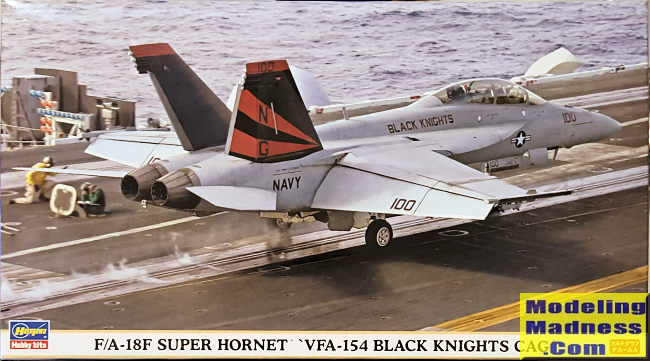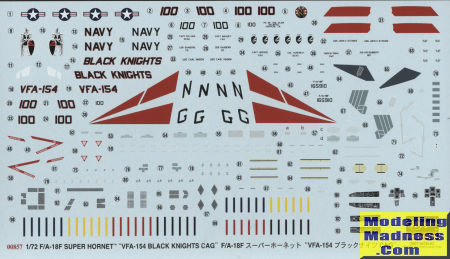
Hasegawa 1/72 F-18F Super Hornet "VFA-154 Black Knights CAG"
| KIT #: | 00857 |
| PRICE: | 2200 yen SRP |
| DECALS: | Two options |
| REVIEWER: | Scott Van Aken |
| NOTES: | 2007 Limited Edition |

| HISTORY |
Designed and initially produced by McDonnell Douglas, the Super Hornet first flew in 1995. Full-rate production began in September 1997, after the merger of McDonnell Douglas and Boeing the previous month. The Super Hornet entered service with the United States Navy in 1999, replacing the Grumman F-14 Tomcat, which was retired in 2006; the Super Hornet serves alongside the original Hornet. The Royal Australian Air Force (RAAF), which has operated the F/A-18A as its main fighter since 1984, ordered the F/A-18F in 2007 to replace its aging F-111 fleet. RAAF Super Hornets entered service in December 2010.
In September 2014, Boeing readied plans to close its St. Louis production lines for the Super Hornet in 2017. However, thanks to some overseas orders and continuing development problems with the F-35, the type is slated to stay in production until 2025 with the USN alone ordering an additional 100 airframes.
| THE KIT |
 The
F-18F replaced, for the most part, the Tomcat in those VF squadrons that were not disestablised
when the F-14 was taken out of fleet service. Hasegawa was one of the first to
provide a full production F-18E/F kit, much to the delight of modelers of the
super bug. Since then, Academy has produced a full line of Hornets, however
those are later production versions and there are a few differences that
enthusiasts are sure to notice. This includes the modified upper rear fuselage
vents though you can get those with aftermarket if you wish.
The
F-18F replaced, for the most part, the Tomcat in those VF squadrons that were not disestablised
when the F-14 was taken out of fleet service. Hasegawa was one of the first to
provide a full production F-18E/F kit, much to the delight of modelers of the
super bug. Since then, Academy has produced a full line of Hornets, however
those are later production versions and there are a few differences that
enthusiasts are sure to notice. This includes the modified upper rear fuselage
vents though you can get those with aftermarket if you wish.
To give you some idea on this kit, it has about 98% commonality with their F-18E kit. The main differences being the fuselage with the two seat format and the additional seat, stick and instrument panel required by that variant. There is also a longer canopy which has a seam that you will need to remove.
So you get a standard Hasegawa cockpit with an acceptable pair of seats and decals for the instruments. The cockpit sits atop a lower forward fuselage piece that includes the nose gear well. One does have to open holes in the fuselage and wings for various pylons so keep that in mind when building it. There is also a piece that fits in the back with polycaps so you can simply push the horizontal stabilizers in place after painting everything. The intakes look simple but are a bit of a challenge to get installed properly. It is the curse of F-18 kits.
Wings have upper and lower pieces on each side with the flaps and ailerons molded into the top wing. Landing gear are properly complex and it looks like you can model them closed. Burner cans fit on the back of the fuselage and there is little depth to the exhaust. Unlike some Hasegawa kits, this one comes with not only fuel tanks, but also some weapons, specifically a pair of late model Sidewinders and some AIM-120s. The racks for bombs are also provided but you'll have to sources those from a weapons set. Note that the wing racks are slightly angled outward. Canopy can be modeled open or closed. In all, a very standard Hasegawa kit.
 Markings are for
two slightly different variations on the same aircraft. The main difference
between them is that one as shown on the box art, is from 2006 when aboard the
USS John Stenis. The other has a slightly different code font, the unit's logo,
and is from 2005 when on the Carl Vinson. You are also provided with missile
bands as well. These are modern Hasegawa decals so will work as good as any
aftermarket. The various walk areas as well as instrument panels are provided on
the sheet as well.
Markings are for
two slightly different variations on the same aircraft. The main difference
between them is that one as shown on the box art, is from 2006 when aboard the
USS John Stenis. The other has a slightly different code font, the unit's logo,
and is from 2005 when on the Carl Vinson. You are also provided with missile
bands as well. These are modern Hasegawa decals so will work as good as any
aftermarket. The various walk areas as well as instrument panels are provided on
the sheet as well.
| CONCLUSIONS |
While it is not a shake and bake kit, it is one that goes together fairly well if you are a careful builder. I have built another boxing which you can read at this link. For those who haven't already realized it, Hasegawa likes to do a lot of Limited Edition boxings of their kits. This is actually fairly wise marketing as often modelers don't want to deal with aftermarket decals when they build a kit, preferring to do their kits straight from the box. In addition, since most of their sales are home market, you'll find CAG-5 planes like this one to be done more often than some others.
| REFERENCES |
https://en.wikipedia.org/wiki/Boeing_F/A-18E/F_Super_Hornet
December 2019
Copyright ModelingMadness.com. All rights reserved.
If you would like your product reviewed fairly and fairly quickly, please contact the editor or see other details in the
Note to
Contributors. Back to the Main Page
Back to the Review
Index Page
Back to the Previews Index Page